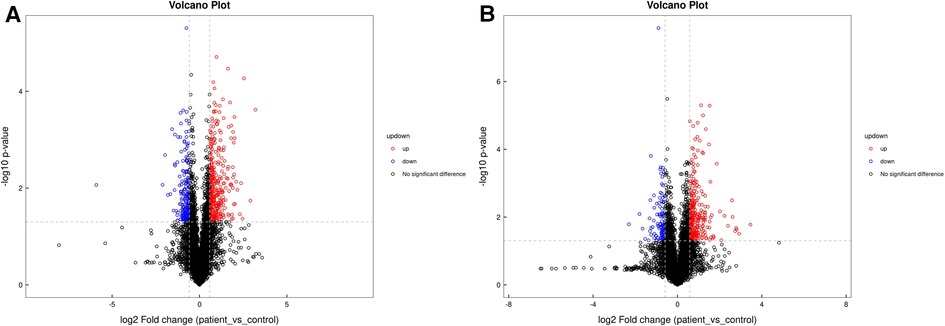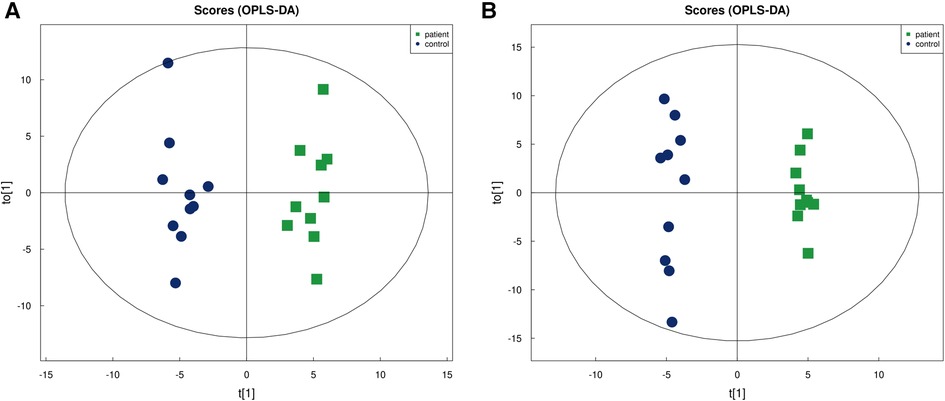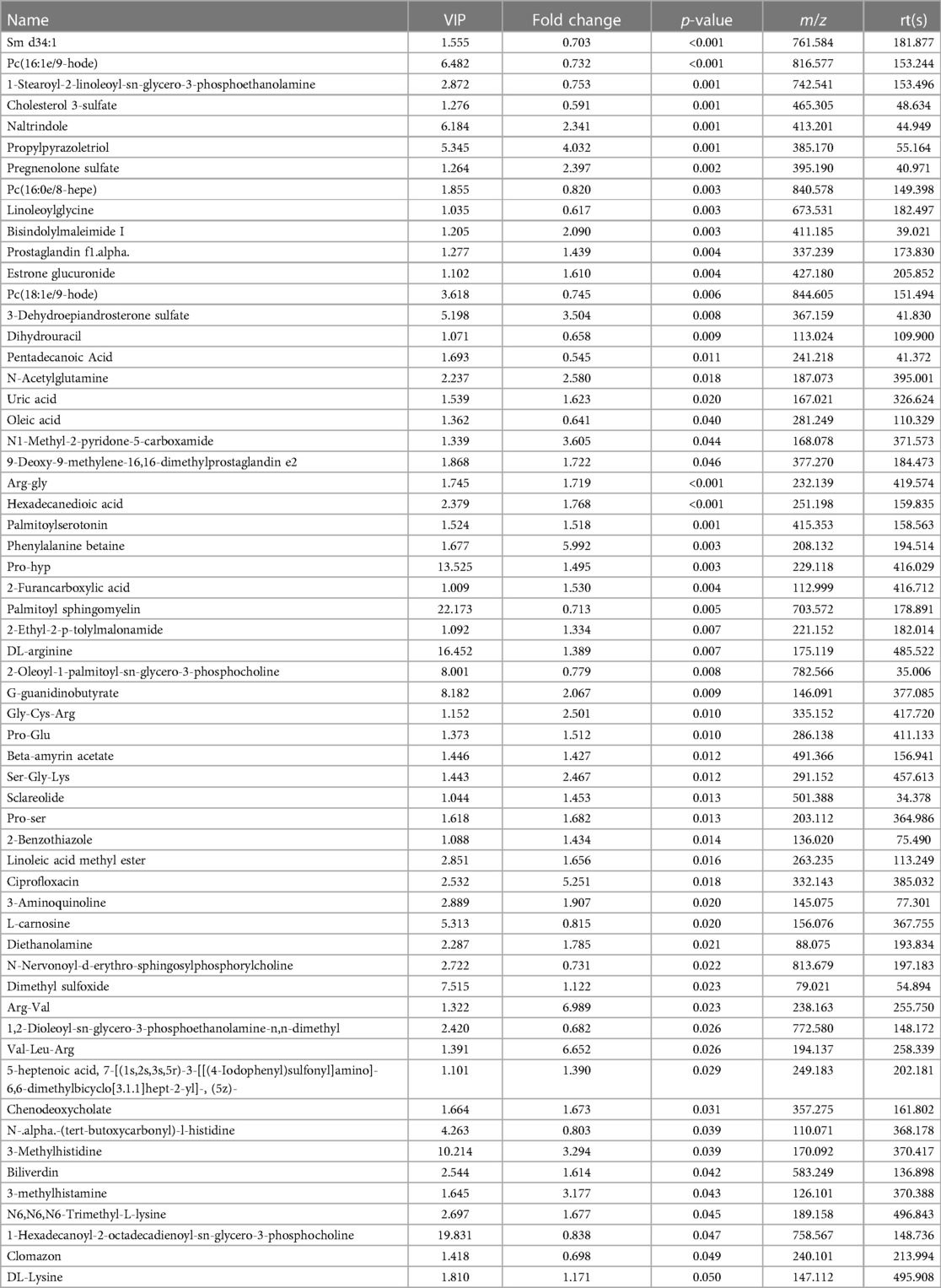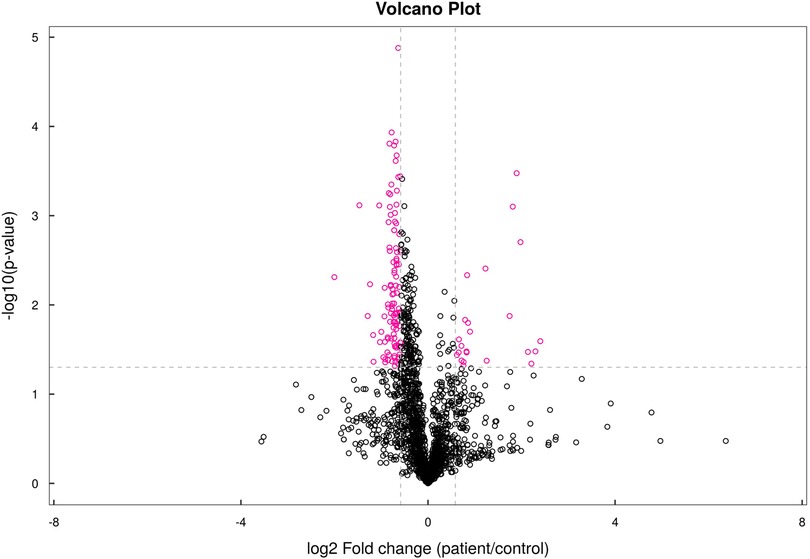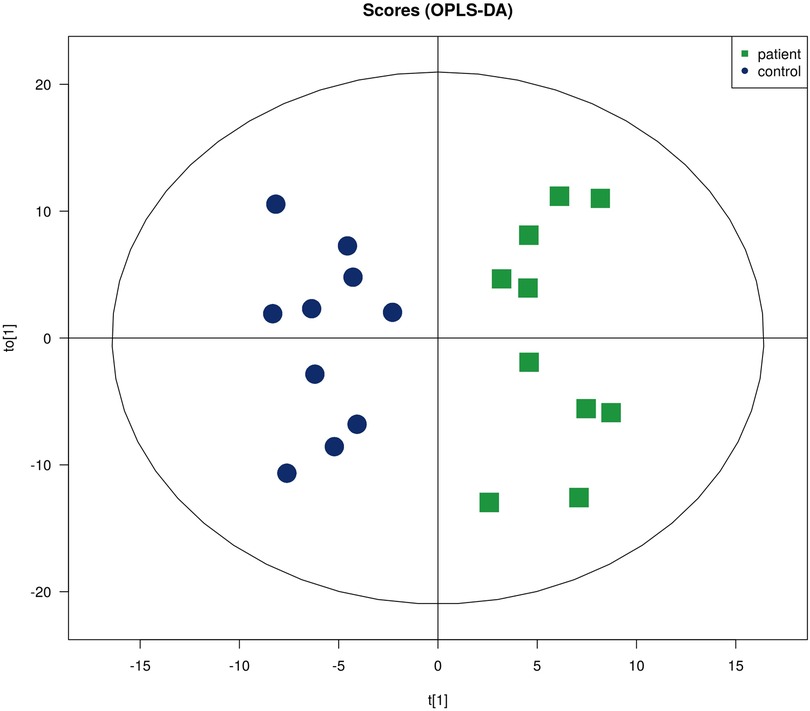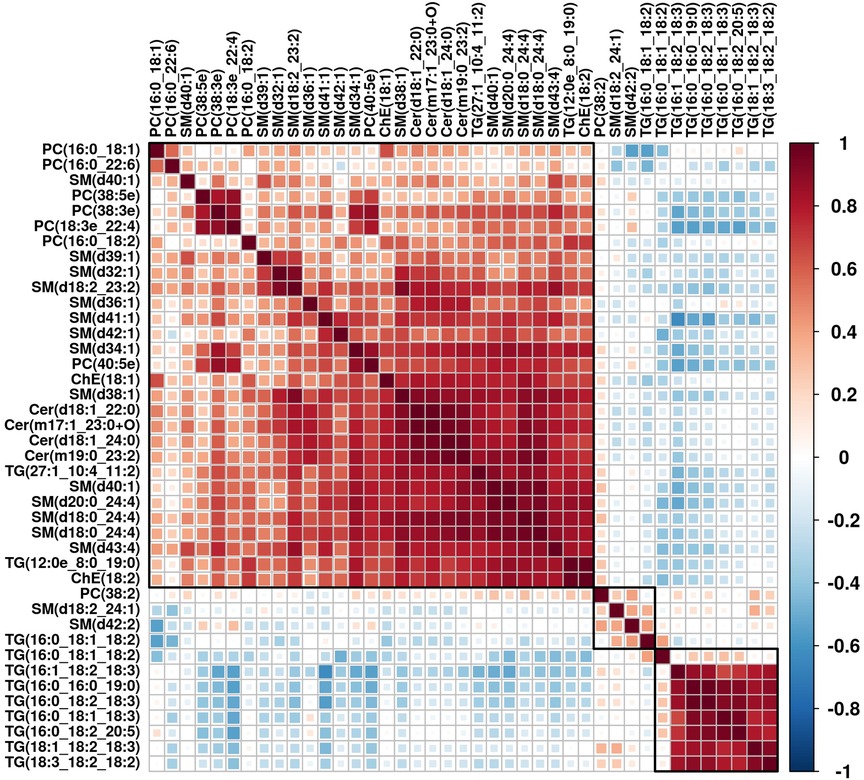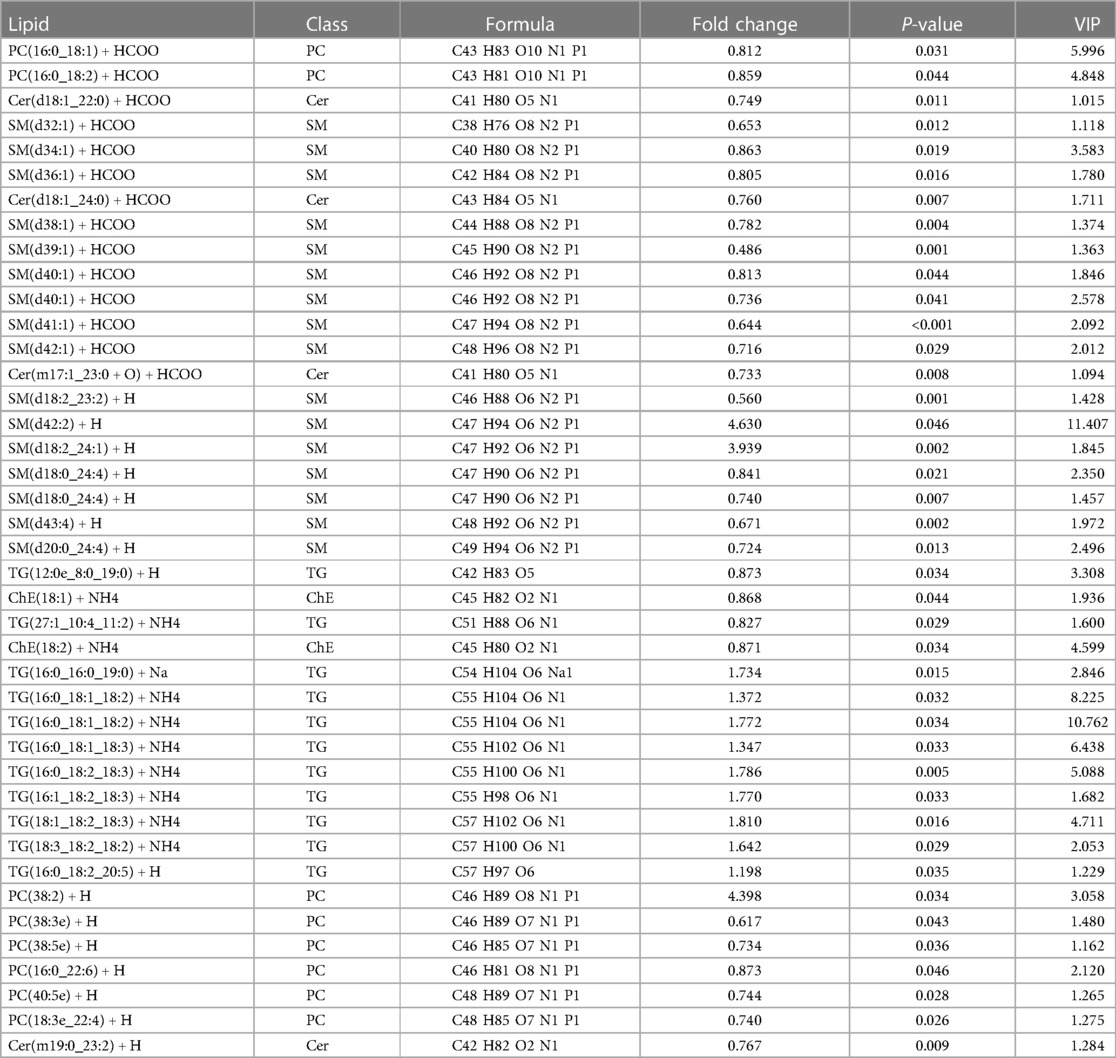- 1Pediatric Department, Zhongshan Hospital, Xiamen University, Xiamen, China
- 2School of Medicine, Xiamen University, Xiamen, China
- 3Center of Clinical Laboratory, Zhongshan Hospital, Xiamen University, Xiamen, China
Objective: Central precocious puberty (CPP) is a rare condition that causes early sexual development in children. Although the cure is effective, the etiology of central precocious puberty is unclear.
Methods: In total, 10 girls with central precocious puberty and same number of age-matched female controls were enrolled. Plasma samples were collected from each participant and subjected to untargeted metabolomics and lipidomics. Student's t-tests were employed to compare the mean of each metabolite and lipid. Furthermore, orthogonal partial least-squares discriminant analysis was conducted and the variable importance in the projection was calculated to identify differentially expressed metabolites or lipids. Subsequent bioinformatics was conducted to investigate the potential function of differentially expressed metabolites and lipids.
Results: Fifty-nine differentially expressed metabolites were identified based on the criteria used (variable importance in the projection >1 and a P value < 0.05). Kyoto Encyclopedia Genes and Genome (KEGG) enrichment analysis showed that differentially expressed metabolites were enriched in four pathways: beta-alanine metabolism, histidine metabolism, bile secretion, and steroid hormone biosynthesis. As for the lipidomics, 41 differentially expressed lipids were observed and chain length analysis and lipid saturation analysis yielded similar results. Significant differences between the two groups were only observed in (O-acyl) ω-hydroxy fatty acids (OAHFA).
Conclusion: The present study showed that antibiotic overuse, increased meat consumption, and obesity may have potential roles in the development of central precocious puberty in girls. Several metabolites have diagnostic value but further research is required.
Introduction
Central precocious puberty (CPP) refers to a rare condition that causes early sexual development in children. Normally, children are considered to have precocious puberty if it begins before 8 years of age in girls and before 9 years of age in boys. Sexual development, growth, and even behavioral changes can be attributed to activation of the hypothalamic–pituitary–gonadal axis, which is a complex central nervous system network (1, 2). The central nervous system network includes several neuronal populations in the hypothalamus, the pituitary gonadotrophic cells, and the gonads. The key molecular messenger of puberty is hypothalamic decapeptide gonadotropin-releasing hormone (GnRH), and the release of GnRH causes the synthesis and release of two gonadotrophins, luteinizing hormone and follicle stimulating hormone, into the peripheral circulation. The gonadotrophins in the peripheral circulation stimulate the gonads to produce sex steroid hormones and gametes, which leads to pubertal changes, such as the growth of pubic and underarm hair, height growth, and the development of breasts in girls.
There are existing studies reporting the epidemiological characteristics of CPP, and they showed that the incidence of CPP varies greatly between countries and by gender. Kim et al. (3) conducted a study based on data from a national registry in South Korea and reported an overall incidence of CPP of 12.28 per 10,000 persons (26.28 in girls and 0.7 in boys). In a study in a French population, the incidence of CPP was 2.68 per 10,000 in girls and 0.24 per 10,000 in boys, according to a national insurance database (4). By contrast, the incidence of CPP was relatively low in a Spanish population (0.217 in girls and 0.023 in boys) in a study involving 34 pediatric endocrinology units throughout the country (5). A prospective study in Denmark from 1998 to 2017 revealed a steady growth in the incidence of CPP during the observation period, indicating that CPP is a public health matter that requires immediate intervention to preserve the well-being of children (6).
CPP is treatable with several medications that block the production of luteinizing hormone and follicle stimulating hormone, and consequently stop the progression of CPP. The safest and most effective option is the use of long-acting GnRH analogs, and an extended-release formulation of GnRH analogs is now available, which provides a more convenient solution for both patients and healthcare providers (7, 8). Although treatment for CPP is effective and has been used worldwide, the etiology of CPP is a complex interaction between genetic factors, environmental exposure, nutritional status (9–11), and other potential influencers. Metabolic status is closely associated with puberty (12). As an example, the average age of menarche for girls in the early 19th century was 17 years but had dramatically declined to 13 years by the middle of the 20th century. The change in the age of menarche can be largely attributed to improved nutrition and better socioeconomic conditions (13).
Several metabolites were altered in urine samples of CPP patients; also, the catecholamine metabolic pathway, tryptophan metabolic pathway, and tricarboxylic acid (TCA) cycle were also altered (14). Recently, Li et al. (15) conducted an integrated analysis of proteomics and metabolomics in girls with CPP. The results showed that differentially expressed metabolites (DEM) were enriched in lipid and taurine pathways, while several proteins (including MMP9, TIMP1, and SPP1) were associated with puberty development. Taken together, previous research findings indicate that lipid metabolism and nutritional status, especially obesity, have an important role in the development of CPP.
To investigate changes in lipids and metabolites in CPP patients, we conducted a comprehensive investigation combining untargeted metabolomics and lipidomics. We also explored pathways and potential biomarkers for the etiology and diagnosis of CPP.
Materials and methods
Study participants
Enrollment of study participants was conducted between October 2021 and August 2022 in the Pediatric Department of Zhongshan Hospital Xiamen University. The inclusion of female CPP patients was based on a consensus report on the diagnosis and treatment of CPP published by the Chinese Medical Association (16). Study participants who met the following criteria were included in the CPP group: (1) breast development before 8 years of age; (2) linear growth acceleration involving a higher than normal annual growth rate; (3) progressive bone age more than 1 year above the chronological age; (4) pelvic ultrasound of the uterus revealing a length of 3.4 cm–4.0 cm, an ovarian volume of 1–3 ml, and the presence of multiple follicles ≥4 mm in diameter; and (5) an luteinizing hormone peak ≥5 IU/l and an luteinizing hormone/follicle stimulating hormone peak ≥0.6 after GnRH stimulation.
Healthy controls were selected from female children who visited the hospital for routine medical examination, matched by age to CPP patients. In total, 10 female CPP patients and the same number of female controls were included in the present study. The study was approved by the Ethics Committee of Zhongshan Hospital, Xiamen University. Informed consent was obtained from the legal guardians of each study participant. This study was carried out in accordance with the Declaration of Helsinki.
Sample collection
Heparin-anticoagulated blood samples were collected from each study participant in the morning after fasting for at least 8 h. After collection, samples were centrifuged at 4 °C and 3,000 rpm for 10 min to separate plasma. Plasma was immediately transferred into an Eppendorf tube and stored at −80 °C before subsequent analyses.
Metabolomics
The plasma samples were thawed at 4 °C and 100 µl aliquots were mixed with 400 µl of cold methanol/acetonitrile (1:1, v/v) to remove the protein. The mixture was centrifuged for 20 min (14,000g, 4 °C). The supernatant was dried in a vacuum centrifuge (17). For LC-MS analysis, the samples were re-dissolved in 100 µl acetonitrile/water (1:1, v/v) solvent and centrifuged at 14,000g at 4 °C for 15 min, then the supernatant was injected. Untargeted metabolomics analyses were performed using an ultra-high performance liquid chromatography (UHPLC) (1290 Infinity LC, Agilent Technologies) coupled to a quadrupole time-of-flight (AB Sciex TripleTOF 6600).
For HILIC separation, samples were analyzed using a 2.1 mm × 100 mm ACQUIY UPLC BEH Amide 1.7 µm column (waters, Ireland). In both ESI positive and negative modes, the mobile phase contained A = 25 mM ammonium acetate and 25 mM ammonium hydroxide in water and B = acetonitrile. The gradient was 95% B for 0.5 min and was linearly reduced to 65% in 6.5 min, and then was reduced to 40% in 1 min and kept for 1 min, and then increased to 95% in 0.1 min, with a 3 min re-equilibration period employed. The ESI source conditions were set as follows: Ion Source Gas1 (Gas1) as 60, Ion Source Gas2 (Gas2) as 60, curtain gas (CUR) as 30, source temperature: 600 °C, IonSpray Voltage Floating (ISVF) ± 5,500 V. In MS only acquisition, the instrument was set to acquire over the m/z range 60–1,000 Da, and the accumulation time for TOF MS scan was set at 0.20 s/spectra. In auto MS/MS acquisition, the instrument was set to acquire over the m/z range 25–1,000 Da, and the accumulation time for product ion scan was set at 0.05 s/spectra. The product ion scan is acquired using information dependent acquisition (IDA) with high sensitivity mode selected. The parameters were set as follows: the collision energy (CE) was fixed at 35 V with ±15 eV; declustering potential (DP), 60 V (+) and −60 V (−); exclude isotopes within 4 Da, candidate ions to monitor per cycle: 10.
Raw MS data were converted into MzXML files using ProteoWizard MSConvert before being imported into freely available XCMS software. The following parameters were used to identify peaks: centWave m/z = 0 ppm, peakwidth = c (10, 60), and prefilter = c (10, 100). For peak grouping, the following parameters were used: bw = 5, mzwid = 0.025, and minfrac = 0.5. CAMERA (Collection of Algorithms of MEtabolite pRofile Annotation) was used for annotation of isotopes and adducts. In the extracted ion features, only variables having more than 50% of the nonzero measurement values in at least one group were kept. Compound identification of metabolites was performed by comparing the accuracy of m/z values (<10 ppm), and by analyzing MS/MS spectra using an in-house database established with available authentic standards. After sum-normalization, the processed data were analyzed using R package (ropls), and multivariate data analysis was carried out, including Pareto-scaled principal component analysis and orthogonal partial least-squares discriminant analysis (OPLS-DA). Seven-fold cross-validation and response permutation testing was used to evaluate the robustness of the model. The variable importance in the projection value of each variable in the OPLS-DA model was calculated to indicate its contribution to the classification. The Student's t-test was applied to determine the significance of differences between two groups of independent samples. Variable importance in the projection (VIP) > 1 and a P value < 0.05 were used to screen significantly changed metabolites. Pearson's correlation analysis was performed to determine the correlation between two variables.
Lipidomics
Lipids were extracted according to Methyl-tert-Butyl Ether (MTBE)method (18). Briefly, a 200-µl volume of water was added to 30 mg sample and vortexed for 5 s. Subsequently, 240 µl of precooling methanol was added and the mixture vortexed for 30 s. After that, 800 µl of MTBE was added and the mixture was ultrasound 20 min at 4 °C followed by sitting still for 30 min at room temperature. The solution was centrifuged at 14,000g for 15 min at 10 °C and the upper organic solvent layer was obtained and dried under nitrogen. Reverse phase chromatography was selected for LC separation using a CSH C18 column (1.7 µm, 2.1 mm × 100 mm, Waters). The lipid extracts were re-dissolved in 200 µl 90% isopropanol/acetonitrile, centrifuged at 14,000×g for 15 min and 3 µl of the sample was injected. Solvent A was acetonitrile–water (6:4, v/v) with 0.1% formic acid and 0.1 Mm ammonium formate, and solvent B was acetonitrile–isopropanol (1:9, v/v) with 0.1% formic acid and 0.1 Mm ammonium formate. The initial mobile phase was 30% solvent B at a flow rate of 300 µl/min. It was held for 2 min and then linearly increased to 100% solvent B in 23 min, followed by equilibrating with 5% solvent B for 10 min.
Mass spectra were acquired by Q-Exactive Plus in both positive and negative modes. ESI parameters were optimized and preset for all measurements as follows: a source temperature of 300 °C; a capillary temperature of 350 °C; an ion spray voltage of 3,000 V; and an S-lens RF level of 50%. The scan range of the instruments was set at 200–1,800 m/z. “Lipid Search” is a search engine for the identification of lipid species based on MS/MS math. LipidSearch contains more than 30 lipid classes and more than 1,500,000 fragment ions in the database. Both mass tolerance for precursor and fragment were set to 5 ppm (19).
Results
Metabolomics
Untargeted metabolomics analysis identified 866 metabolites in positive ion mode and 302 in negative ion mode. Based on the results of Student's t-tests and fold change analysis (FC), metabolites were selected with an FC > 1.5 or <0.67 and a P value <0.05 (Figures 1A,B). In OPLS-DA, R2Y and Q2 were 0.962 and 0.574, respectively, in positive ion mode, and the corresponding parameters in negative ion mode were 0.991 and 0.496, respectively. As can be seen in Figures 2A,B, the CPP of patients and controls were clearly separated in both positive and negative ion modes, indicating that OPLS-DA was effective. A permutation test was conducted to evaluate the robustness of OPLS-DA, showing that R2Y and Q2 gradually decreased in both positive and negative ion modes, and were lower than those of the actual dataset, suggesting that there was no overfitting of the model.
Furthermore, we applied the following criteria to identify DEM if they had a variable importance in the projection calculated from OPLS-DA > 1 and a P value <0.05. In total, 38 metabolites in the positive ion mode and 21 in the negative ion mode were identified as DEMs, and detailed information of DEMs is displayed in Table 1. Hierarchical clustering based on DEMs showed clear separation between groups and similarity inside groups in both positive negative ion modes (Figures 3A,B). Kyoto Encyclopedia Genes and Genome (KEGG) enrichment analysis was also performed and the results showed that DEMs were enriched in four pathways: beta-alanine metabolism, histidine metabolism, bile secretion, and steroid hormone biosynthesis.
Lipidomics
In total, lipidomics analysis identified 1,831 lipid species in 41 lipid classes. Similarly, FC analysis and Student's t-tests were used to find lipid species that were significantly different between CPP patients and controls. The pink dots in the volcano plot show lipid species with an FC > 1.5 or <0.67 and a P value < 0.05 (Figure 4). OPLS-DA yielded R2Y and Q2 values of 0.896 and 0.420, respectively, suggesting that the model was stable and effective. In addition, Figure 5 of OPLS-DA shows a clear separation between CPP patients and controls.
A permutation test was also conducted and showed that the model had no overfitting. To identify differentially expressed lipids (DEL), the same criteria used to find DEM were applied. As a result, 41 DELs were identified, as detailed in Table 2. Clustering analysis showed a clear separation between CPP patients and controls and the heatmap is shown in Figure 6. Correlation analysis was conducted to evaluate the metabolic proximities between DELs. Positive correlation suggests that lipids share the same synthesis pathway and negative correlation suggests that the lipolysis of a lipid contributes to the synthesis of another lipid. The visualization of correlation analysis is presented in Figure 7. Chain length analysis and lipid saturation analysis yielded similar results, and significant differences were only observed for (O-acyl) ω-hydroxy fatty acids (OAHFA) between the two groups.
Discussion
The present study was a comprehensive analysis of untargeted metabolomics and lipidomics in plasma samples collected from CPP patients and controls. The analysis revealed that several metabolites and lipids were differentially expressed between the two groups. The findings may aid understanding of the mechanism of CPP and indicate biomarkers for diagnosis.
The most striking finding was the 5.251-fold elevation of ciprofloxacin in CPP patients compared with controls. Ciprofloxacin is a fluoroquinolone antibiotic used to treat infections caused by bacteria such as pneumonia, typhoid fever, and infectious diarrhea. Fluoroquinolone antibiotics are capable of disrupting the catalytic mechanism of topoisomerase IV and DNA gyrase, and lead to single-stranded and double-stranded DNA breaks (20). Side effects of fluoroquinolone are common and involve several biological systems. Therefore, the application of fluoroquinolone is prohibited in certain populations, especially pregnant women.
An association between fluoroquinolone and CPP has been reported in a cross-sectional study in China. In this study, the detection rate of fluoroquinolone in children with CPP was significantly higher than that in children without CPP (21). Although antibiotics are prescription-only medicines in developed countries including the United States and Canada, they can be easily purchased from pharmacies in China without a prescription. In addition, parents in China often use antibiotics to treat infections in their children because they believe antibiotics are very effective. These two factors have contributed to the overuse of antibiotics in China, and this overuse may be one explanation for the increase in the incidence of CPP.
We also observed a significant elevation of pregnenolone sulfate in CPP patients and the FC reached 2.397. Pregnenolone sulfate is a steroid metabolite with a plethora of functions. Pregnenolone is synthesized from cholesterol by a mitochondrially localized cytochrome P450 side-chain cleavage enzyme and then some of the pregnenolone is converted to pregnenolone sulfate by sulfonation of cytosolic sulfotransferase enzymes (22). Pregnenolone sulfate plays a critical role in the synthesis of steroid hormones, including estradiol and progesterone. It also modulates potassium channels, nicotinic acetylcholine receptors, and voltage-gated sodium channels (23). The elevation of pregnenolone sulfate in the current study may indicate upregulated synthesis of steroid hormones, which is consistent with the definition of CPP. Therefore, it could serve as a biomarker during screening for CPP.
Interestingly, the results showed that levels of propyl pyrazole triol, an estrogen receptor alpha agonist, were approximately four time higher in CPP patients than controls. In an animal model, the application of propyl pyrazole triol was very effective in stimulating uterine weight gain and upregulating complement 3 gene expression, as well as stimulating other physiologically relevant estrogen-induced tissue responses (24). Similar to the elevation of pregnenolone sulfate, an increase of propyl pyrazole triol contributes to pubertal changes, such as uterine growth.
KEGG pathway analysis showed that DEMs were enriched in several pathways, including steroid hormone biosynthesis (which is explained by the above-mentioned metabolites) and histidine metabolism. The key DEM in histidine metabolism we identified was 3-methylhistamine, which was increased three-fold in CPP patients. This histamine metabolite is an index of the rate of muscle protein breakdown. Consequently, its measurement in urine is often used to evaluate the physical activity of professional athletes. It originates from the consumption of protein-rich foods, for example, meat and soy products. A previous study revealed that increased excretion of 3-methylhistamine was associated with food consumption (25). In the contemporary livestock industry, hormones such as estrogens are often administered to growing cattle to promote growth, enabling them to be ready for production earlier. As a result, the residue of hormones in meat products has become a serious problem in food safety. Xu et al. (26) conducted an investigation into the estrogen residue of livestock manure and found that estrogen levels were highest in the manure of finishing pigs, followed by growing pigs, and piglets. Our findings may reflect high levels of estrogen residues in meat products, promoting CPP in susceptible individuals with high meat consumption.
We also performed lipidomics to investigate changes in lipids in CPP patients. In total, 41 DELs were identified and according to the results of Student's t-tests, most of PC, SM and ChE were decreased in CPP patients while most TGs were upregulated. TG elevation suggests that CPP patients may be overweight or consume a diet high in meat products, which are also contaminated with antibiotics and estrogen residues. In the correlation analysis, lipids within the same class showed strong correlation, suggesting that they interact with each other. The function of some DELs should be further explored, especially those in SM, which have an important function in neuronal activity.
Conclusion
In conclusion, we conducted untargeted metabolomics and lipidomics analyses in plasma samples collected from CPP patients and controls. The data analysis revealed several DEMs and DELs that hold potential to be biomarkers. These DEMs and DELs could also improve understanding of the underlying mechanisms of CPP. Several KEGG pathways were enriched in DEMs and could provide valuable information concerning CPP. The increasing incidence of CPP may be associated with the overuse of antibiotics and the consumption of meat products that contain high level of estrogen. Moreover, obesity and fat accumulation caused by increased food consumption also contributes to the development of CPP. The major limitation of our study is the sample size, considering the incidence, the number of children, and potential hospital visit, as well as the multi-omics approach we applied, we are able to conduct such study in a large sample size. Moreover, the sample size limits the possibility of introducing factors such as social-economic status, dietary intake to our analysis. The findings should be validated in a larger sample size. In addition, cell assays are required to clarify the functional roles of the DEMs and DELs in the development of CPP.
Data availability statement
The raw data supporting the conclusions of this article will be made available by the authors, without undue reservation.
Ethics statement
The studies involving human participants were reviewed and approved by the Ethics Committee of Zhongshan Hospital, Xiamen University. Written informed consent to participate in this study was provided by the participants’ legal guardian/next of kin.
Author contributions
W-SS and R-LG conceptualized the research goals, planned the analyses and guided the literature review. H-YZ and Y-RZ conducted the patient recruitment, sample collection and manuscript writing. RZ and Y-TL performed the experiment and data analysis. All authors contributed to the article and approved the submitted version.
Funding
The study was financially supported by a grant from the Xiamen Guidance Research Program on Health (No. 3502Z20224ZD1048). The funders had no role in the design, conduct, data collection, analysis, and interpretation of data or in writing the manuscript.
Conflict of interest
The authors declare that the research was conducted in the absence of any commercial or financial relationships that could be construed as a potential conflict of interest.
Publisher's note
All claims expressed in this article are solely those of the authors and do not necessarily represent those of their affiliated organizations, or those of the publisher, the editors and the reviewers. Any product that may be evaluated in this article, or claim that may be made by its manufacturer, is not guaranteed or endorsed by the publisher.
Supplementary material
The Supplementary Material for this article can be found online at: https://www.frontiersin.org/articles/10.3389/fped.2023.1157272/full#supplementary-material.
References
1. Avendaño MS, Vazquez MJ, Tena-Sempere M. Disentangling puberty: novel neuroendocrine pathways and mechanisms for the control of mammalian puberty. Hum Reprod Update. (2017) 23:737–63. doi: 10.1093/humupd/dmx025
2. Brito VN, Canton APM, Seraphim CE, Abreu AP, Macedo DB, Mendonca BB, et al. The congenital and acquired mechanisms implicated in the etiology of central precocious puberty. Endocr Rev. (2023) 44:193–221. doi: 10.1210/endrev/bnac020
3. Kim YJ, Kwon A, Jung MK, Kim KE, Suh J, Chae HW, et al. Incidence and prevalence of central precocious puberty in Korea: an epidemiologic study based on a national database. J Pediatr. (2019) 208:221–8. doi: 10.1016/j.jpeds.2018.12.022
4. Le Moal J, Rigou A, Le Tertre A, De Crouy-Channel P, Léger J, Carel JC. Marked geographic patterns in the incidence of idiopathic central precocious puberty: a nationwide study in France. Eur J Endocrinol. (2018) 178:33–41. doi: 10.1530/EJE-17-0379
5. Soriano-Guillén L, Corripio R, Labarta JI, Cañete R, Castro-Feijóo L, Espino R, et al. Central precocious puberty in children living in Spain: incidence, prevalence, and influence of adoption and immigration. J Clin Endocrinol Metab. (2010) 95:4305–13. doi: 10.1210/jc.2010-1025
6. Bräuner EV, Busch AS, Eckert-Lind C, Koch T, Hickey M, Juul A. Trends in the incidence of central precocious puberty and normal variant puberty among children in Denmark, 1998 to 2017. JAMA Netw Open. (2020) 3:e2015665. doi: 10.1001/jamanetworkopen.2020.15665
7. Swerdloff RS, Heber D. Superactive gonadotropin-releasing hormone agonists. Annu Rev Med. (1983) 34:491–500. doi: 10.1146/annurev.me.34.020183.002423
8. Carel JC, Blumberg J, Seymour C, Adamsbaum C, Lahlou N, Triptorelin 3-month CPP Study Group. Three-month sustained-release triptorelin (11.25 mg) in the treatment of central precocious puberty. Eur J Endocrinol. (2006) 154:119–24. doi: 10.1530/eje.1.02056
9. Tng EL. Kisspeptin signalling and its roles in humans. Singapore Med J. (2015) 56:649–56. doi: 10.11622/smedj.2015183
10. Parent AS, Franssen D, Fudvoye J, Pinson A, Bourguignon JP. Current changes in pubertal timing: revised vision in relation with environmental factors including endocrine disruptors. Endocr Dev. (2016) 29:174–84. doi: 10.1159/000438885
11. Dündar İ, Akıncı A. Prevalence of type 2 diabetes mellitus, metabolic syndrome, and related morbidities in overweight and obese children. J Pediatr Endocrinol Metab. (2022) 35:435–41. doi: 10.1515/jpem-2021-0271
12. Ilich JZ, Badenhop NE, Jelic T, Clairmont AC, Nagode LA, Matkovic V. Calcitriol and bone mass accumulation in females during puberty. Calcif Tissue Int. (1997) 61:104–9. doi: 10.1007/s002239900304
13. Huang A, Reinehr T, Roth CL. Connections between obesity and puberty: invited by manuel tena-sempere, cordoba. Curr Opin Endocr Metab Res. (2020) 14:160–8. doi: 10.1016/j.coemr.2020.08.004
14. Qi Y, Li P, Zhang Y, Cui L, Guo Z, Xie G, et al. Urinary metabolite markers of precocious puberty. Mol Cell Proteomics. (2012) 11:M111.011072. doi: 10.1074/mcp.M111.011072
15. Li M, Lan D, Chen Y. Integrated analysis of proteomics and metabolomics in girls with central precocious puberty. Front Endocrinol (Lausanne). (2022) 13:951552. doi: 10.3389/fendo.2022.951552
16. Subspecialty Group of Endocrinologic, Hereditary and Metabolic Diseases, the Society of Pediatrics, Chinese Medical Association. Consensus statement for the diagnosis and treatment of central precocious puberty. Chin J Pediatr. (2015) 53:412–8. doi: 10.3760/cma.j.issn.0578-1310.2015.06.004
17. Patterson RE, Ducrocq AJ, McDougall DJ, Garrett TJ, Yost RA. Comparison of blood plasma sample preparation methods for combined LC-MS lipidomics and metabolomics. J Chromatogr B Analyt Technol Biomed Life Sci. (2015) 1002:260–6. doi: 10.1016/j.jchromb.2015.08.018
18. Matyash V, Liebisch G, Kurzchalia TV, Shevchenko A, Schwudke D. Lipid extraction by methyl-tert-butyl ether for high-throughput lipidomics. J Lipid Res. (2008) 49:1137–46. doi: 10.1194/jlr.D700041-JLR200
19. Wu T, Guo H, Lu Z, Zhang T, Zhao R, Tao N, et al. Reliability of LipidSearch software identification and its application to assess the effect of dry salting on the long-chain free fatty acid profile of tilapia muscles. Food Res Int. (2020) 138(Pt B):109791. doi: 10.1016/j.foodres.2020.109791
20. Fief CA, Hoang KG, Phipps SD, Wallace JL, Deweese JE. Examining the impact of antimicrobial fluoroquinolones on human DNA topoisomerase IIα and IIβ. ACS Omega. (2019) 4:4049–55. doi: 10.1021/acsomega.8b03428
21. Hu Y, Li J, Yuan T, Yu T, Chen Y, Kong H, et al. Exposure to antibiotics and precocious puberty in children: a school-based cross-sectional study in China. Environ Res. (2022) 212:113365. doi: 10.1016/j.envres.2022.113365
22. Strott CA. Sulfonation and molecular action. Endocr Rev. (2002) 23:703–32. doi: 10.1210/er.2001-0040
23. Horishita T, Ueno S, Yanagihara N, Sudo Y, Uezono Y, Okura D, et al. Inhibition by pregnenolone sulphate, a metabolite of the neurosteroid pregnenolone, of voltage-gated sodium channels expressed in Xenopus oocytes. J Pharmacol Sci. (2012) 120:54–8. doi: 10.1254/jphs.12106SC
24. Harris HA, Katzenellenbogen JA, Katzenellenbogen BS. Characterization of the biological roles of the estrogen receptors, ERalpha and ERbeta, in estrogen target tissues in vivo through the use of an ERalpha-selective ligand. Endocrinology. (2002) 143:4172–7. doi: 10.1210/en.2002-220403
25. Imamura I, Watanabe T, Maeyama K, Kubota A, Okada A, Wada H. Effect of food intake on urinary excretions of histamine, N tau-methylhistamine, imidazole acetic acid and its conjugate(s) in humans and mice. J Biochem. (1984) 96:1931–7. doi: 10.1093/oxfordjournals.jbchem.a135028
Keywords: central precocious puberty, metabolomics, lipidomics, metabolites, diagnostic value
Citation: Zhao H-Y, Zhang Y-R, Zhang R, Li Y-T, Guo R-L and Shi W-S (2023) Comprehensive analysis of untargeted metabolomics and lipidomics in girls with central precocious puberty. Front. Pediatr. 11:1157272. doi: 10.3389/fped.2023.1157272
Received: 2 February 2023; Accepted: 25 April 2023;
Published: 12 May 2023.
Edited by:
Duarte Miguel Henriques-Neto, University of Maia, PortugalReviewed by:
Dipankar Ghosh, Jawaharlal Nehru University, IndiaSemra Çaglar Çetinkaya, University of Health Sciences, Türkiye
© 2023 Zhao, Zhang, Zhang, Li, Guo and Shi. This is an open-access article distributed under the terms of the Creative Commons Attribution License (CC BY). The use, distribution or reproduction in other forums is permitted, provided the original author(s) and the copyright owner(s) are credited and that the original publication in this journal is cited, in accordance with accepted academic practice. No use, distribution or reproduction is permitted which does not comply with these terms.
*Correspondence: Wen-Sheng Shi c3dzMjAxMTIwMTdAb3V0bG9vay5jb20=
 Hong-Ying Zhao1
Hong-Ying Zhao1 Wen-Sheng Shi
Wen-Sheng Shi